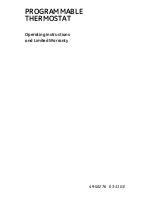
R
2800 LAURA LANE • MIDDLETON, WI 53562 • (800) 288-9383 • FAX (608) 836-9044 • www.tcsbasys.com
9
mable thermostats, the Superstat allows independent
adjustments of “offsets” and “differentials” for stages of
heating and cooling. The offset settings can be viewed
as setpoints for the second and third stages and are
programmed in the Superstat in the number of degrees
(i.e. 1,2,3 ... ) beyond the heating and cooling setpoints
(temperatures to be maintained).
The differential for each stage can be viewed as the
“anticipator” function used in mechanical thermostats.
P + I OPTION
The SZ1009 also has a P+I option. Without enabling
this option, stages turn on and off based on temperature
vs. setpoint alone, as described above. By enabling this
option, you allow a time factor to be added. This is use-
ful when you are forced to have a large differential due
to equipment size. At times when the building load is
low, the temperature could potentially sit a few degrees
off setpoint for some time. With the time factor added,
the thermostat would compensate for this, turning on
the equipment even though the temperature had not
reached the limits described above.
SMART RECOVERY
“Smart Recovery” may be enabled to insure occupant
comfort while saving money. It takes the building load
into consideration and ramps the setpoint when going
from the unoccupied mode to the occupied mode. At the
beginning of the occupied mode, the occupied setpoint
will be reached, many times without the need for the
second stage to come on. This feature is automatically
disabled when DI3 is set to external time clock.
DIGITAL
APPLICATION
LED
SERVICE SCREEN
CONTROL
SENSOR OR
INPUT
INDICATION?
(DI STATUS SCREEN)
PROVIDED
DEVICE NEEDED
DI1
Fan Proving
YES
CHECK FAN,
YES - turns system mode to "off"
Differential
FAN OK
— requires manual re-start
pressure or
or FAIL
(set system to auto)
current switch
DI1
Equipment
NO
OK
NO
Dry contact, switch. Any type
Monitoring
(DI1 OPEN or CLOSED)
for monitoring and indication
DI2
Service Alert
YES
OK or CHECK DI2
NO
Dry contact, switch. Any type
(DI2 SERVICE OFF or ON)
for monitoring and indication
DI2
Monitor with
NO
OK
YES - shifts setpoint by
Dry contact, switch.
setpoint shift
(DI2 OPEN or CLOSED)
programmed amount
DI3
Filter Service
YES
OK or CHECK FILTER
NO
Differential pressure switch
(FILTER OK or CHECK)
DI3
External Occupancy Override
NO
OK
YES - switches to occupied mode
Dry contact such as twist
(EXT OVER ON or OFF)
as long as contact is made
timer, light switch, etc.
DI3
External Time Clock Input*
NO
OK
YES -input overrides thermostat*
Dry contact;
(EXT TIMECLOCK ON or OFF)
occupancy program
external time clock
(TCS part SL1001a)
Digital Input Summary Table
*See delay on Power-up.
BUILT-IN DELAYS
The SZ1009 has delays built into the programming
sequences to protect equipment. The fan has a mini-
mum on and off time of 30 seconds. When the fan is
in AUTO mode, it will come on 30 seconds before the
heating or cooling stages are allowed to sequence on,
and remain on for 2 minutes after the heating or cool-
ing stages sequence off. Each stage has a minimum on
and off time of two minutes. There is a minimum of two
minutes between when one stage turns on until the next
stage is allowed to turn on, as well as when one stage
turns off until the next stage is allowed to turn off.
DELAY ON POWER UP
The SZ1009 has an adjustable delay on power up. When
several thermostats are used at one location, and the
power goes out, most thermostats turn all of the units
back on at the same time on regain of power, creating a
peak. The thermostat allows you to set a value, in sec-
onds, where no outputs are allowed to turn on for that
length of time on power up. Setting each unit to a differ-
ent delay allows you to soft start your system, and thus
prevent this peak.
Note, this
delay is also applied to the
start of occupied time.
HEAT PUMP MODE
If HEAT PUMP mode is selected in programming step 5,
then the SZ1009 will operate in heat pump mode. In
heat pump mode the Y terminal is is used for both heat-
ing and cooling, and the W terminal is used for control
of the reversing valve. The reversing valve is set to be
Open (Unpowered) for cooling by default and can only
be changed through communications.






























